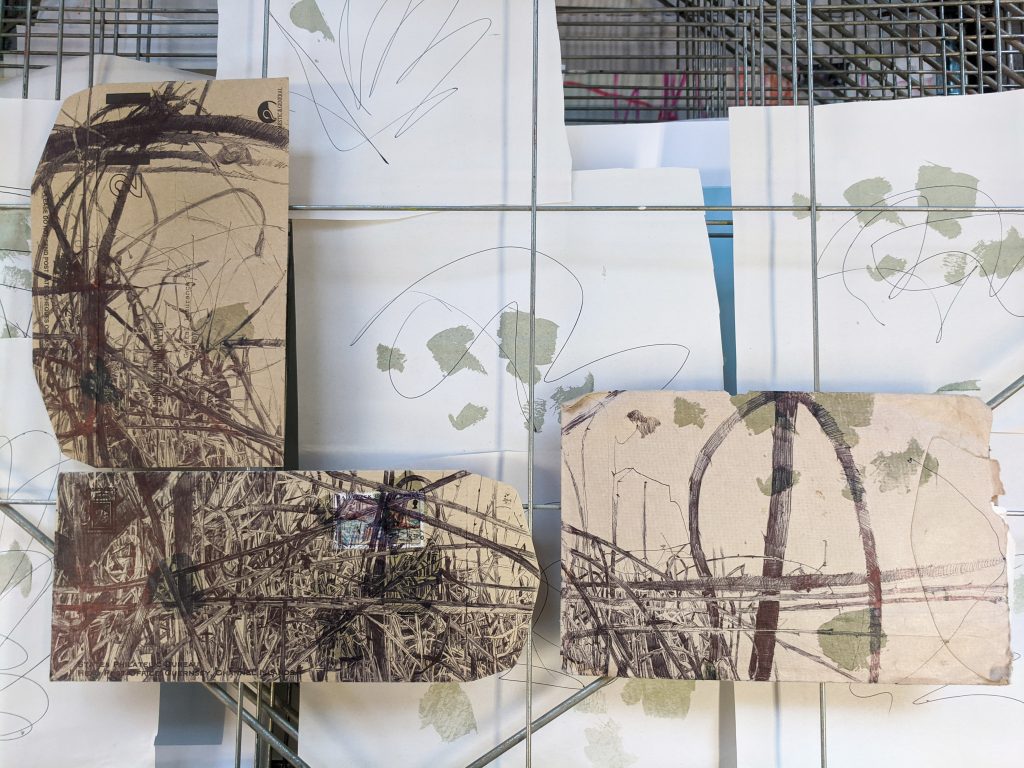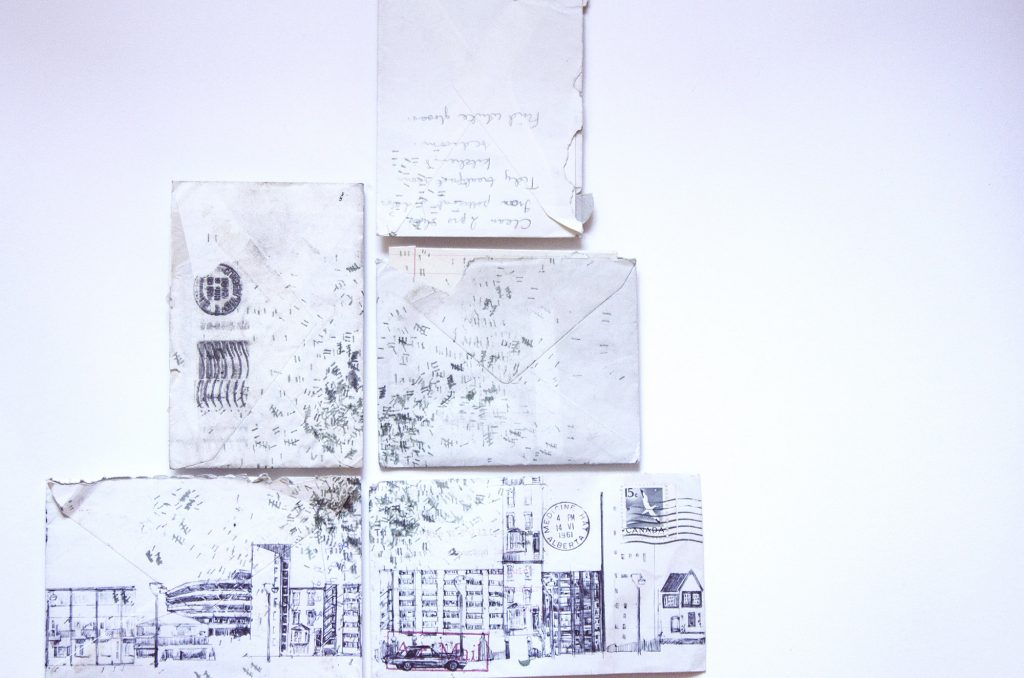Mandy Standard 4 Piece Bedroom Set
Mandy Cleveland
Back of the Envelope series (2020-ongoing)
Drawings on found paper
In collaboration with Hot Bed Press, we are pleased to share new work by Manchester-based artist Mandy Cleveland, one of six new co-commissions for the Collection during Covid-19.
Here, Mandy talks with Stephanie Fletcher, Assistant Curator, about making new drawings that reflect on a personal and global sense of uncertainty during the pandemic.
Read more about Mandy's project here, and more about the Covid commissions programme here.

Mandy Cleveland, Thorny Burr (2020) Drawing on found papers
SF: Can you start by telling us a bit about your background and creative practice?
My time is split between my personal practice as a fine artist, and as a community artist delivering sessions for adults and children. Before Covid I'd usually be in my studio at Hot Bed Press most days, either drawing or getting ready for workshops.
I work on my own practice as much as possible, often under the title 'Back of the Envelope' which involves hand-drawn compositions on old or found envelopes. I also use printmaking – woodcut in particular.
My community arts workshops are delivered with various organisations including Manchester Libraries and Archives, Zion Community Resource Centre, LGBT Proud2bParents, HerArt and Manchester Museums. I've also worked on funded projects about International Women's Day, Art for Wellbeing, and to raise awareness of Hate Crime.
I really believe in supporting community through art projects, and believe that art is a powerful tool for healthy mental wellbeing.
SF: Has lockdown affected your approaches – and if so how?
I've been working from home a lot more, juggling childcare as a single parent and with work all in a small space with inadequate technology!
I lost all of my workshops in the community and that's a very stressful experience when you are self employed as you lose your income. Work did start to come back as organisations wanted online workshops and videos, which meant a completely new approach for me – which was very challenging yet a great sense of achievement when the challenge is met.
Sometimes it feels like we are bombarded with facts and figures [from the news], yet we are isolated in our homes – in some ways we have a 'double experience' as these facts and figures get mixed with our own personal memories and moments. Some people have spoken about how time seemed to move both slowly and quickly – so many things have happened since the end of March it seems like years condensed into months, and all without leaving the house.
In my drawings, I wanted to try and depict this visually and also try to capture a sense of the inaccessibility and confusion, from my own perspective. (Trying to work and provide home-schooling meant getting up at 5.30am to get drawing done!)
SF: You regularly use found papers, e.g the 'back of an envelope'. There is something quite special about combining these throwaway materials with your very delicate drawing practice. Can you tell us a bit more about the materials you are drawn to?
At a subconscious level a great sense of guilt about spending and waste draws me to draw on the old envelopes and old papers. I recognise the absurdity of drawing, carefully filling in the space on the back of a worthless piece of paper, but it's important.
Some envelopes given to me are just junk mail, and others I buy in job lots. Some I find in antique shops and are very old – from 1890 even. I just like that they're floating around forgotten – almost thrown away, but not quite. The old envelopes have carried news sent by one human to another – it's about communication, and these are the carriers of that communication.
In daily life, we might use them to work things out, to write lists on, to remind us about things we may forget. That's perhaps one of the things I'm trying to do: create snapshots of things I might forget, snapshots of the 'mundane'.

Mandy Cleveland Chairs 2020

Mandy Cleveland Buttercup 2020
SF: Images of nature are a recurring motif in your work. Many of us have been reconnecting with nature during lockdown – from noticing birds on the windowsill, to exploring local green spaces, or growing our own veg. What do these images mean to you?
Nature appears in my work as it's all around, but specifically it's more about the eye seeing things.
Noticing a ladybird resting on a blade of grass with outside the laundrette, while about to cross the road to get spare change – it's not really about grand gestures, it's about walking around seeing something here and there.
I draw lots of things and put them together – I want to create a feeling of time passing, of not knowing what to do… like someone who might draw things on envelopes.
I've written about drawing brambles it's because the seemingly endless scribble seems to suit my mood – they're unruly and dark when you look into a patch of them. They're often unwanted and take over spaces – and hard to get rid of. There's quite a few in the back yard of the house I've moved into, and they seem to have sprung from nowhere.
Birds also occur often in my drawings – particularly black feathered birds because they are reminiscent of the British hedgerow. They're scratchy and furtive like my drawings – and they may have a tale to tell. In folklore birds are often messengers – coming back to the idea of 'communication' in my work.
As a lot of people have said, the first phase of lockdown was a profound and scary experience – but also eerily quiet at times. This means that you do notice nature more, you take time to look around. Sometimes you are just staring at the wall in despair feeling generally awful – then you might notice some insects crawling around in your backyard and it will feel quite poignant!
The facts are that lockdown was better for wildlife, the birds, insects and the atmosphere greatly benefited and seemed to thrive in our absence – and I wanted to reflect on this in my drawings.
SF: Occasionally, people appear in your work too – they seem quiet, thoughtful, waiting. Can you talk a bit more about their presence (or in some cases their absence?)
When we watch people in the street, we build up ideas and stories about them – what are they doing? Where are they going? It's the same for the people in my drawings – it's for the viewer to decide what they're doing, what they're waiting for, or who they are. I deliberately set up scenes that seem impassive – creating part of a story and letting the viewer fill in the blanks.
I also started to draw empty chairs during lockdown because, like everyone else, I'm confined to the house and my resources are limited. I was thinking about how to represent 'leaving' a space – and what an empty chair might mean. Is it that we've left our chairs behind at work, in the pub, church or community centres – is it a chair of a loved one who is no longer here? Is it a park bench that we walk past, but can't sit on?
SF: What's next for your practice?
I'm still developing this commission – it's been difficult as I draw a lot and it takes a long time to get ideas or fully formed works. I have also been back to Hotbed Press studios, and I'm starting some editions from my drawings – as well as continuing projects with the community.
As well as building my website, I've been tentatively thinking about animation and video. As someone who mainly works on paper I wouldn't have ever considered such things before lockdown! The thing about the many stages of lockdown appears that we all have to be quite adaptable – it's a very surreal and sad time, but creatively some interesting things are happening.

Mandy Cleveland Works in progress (brambles) 2020

Mandy Cleveland Flying stats murmuration (2020)
Clevelandis an artist based in Manchester with a studio at Hot Bed Press. Her fine art practice is being increasingly recognised, alongside her work within local communities with her company Curious Crafty.
https://mandycleveland.com/
Hot Bed Press aims to support artists, promote printmaking and educate a wider audience in printmaking and related arts. It has been based in Salford since 2006, has an ambitious programme of development and is a key player in the Salford and Manchester arts ecology. https://www.hotbedpress.org/
University of Salford Art Collection is an ambitious and growing collection of over 700 works of modern and contemporary art, founded c1968. The Collection is actively developed through new co-commissions, working directly with artists in order to tell a story of now to future generations.
September 2020
Mandy Standard 4 Piece Bedroom Set
Source: https://artcollection.salford.ac.uk/2020/09/18/mandy-cleveland-back-of-the-envelope/


0 Komentar